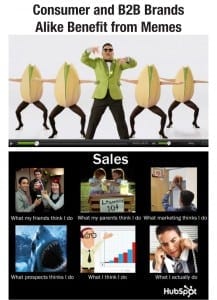Memes: The term may be lost on PR professionals who are not attuned to pop culture or surfing YouTube. No, memes aren’t those silent street performers, nor is the word pronounced mem eees —as one PR News staffer is inclined to say.
Memes are a concept that spreads from person to person via the Web. They come in a variety of forms—written word, spoken phrase, image or video.
So why should PR pros be aware of memes? In the April 9, 2012 issue of PR News, we spoke with David Meerman Scott, who had just written a book on news-jacking, the act of taking a current news event and wrapping your own message around it for PR purposes. News-jacking has proved highly effective at gaining attention from the media and the public.
That tactic has spawned meme-jacking, the act of taking a piece of viral pop culture (think “tiger blood” or the “honey badger” YouTube video) and making it a part of your own PR campaigns.
MEASURING MEMES

The Wonderful Pistachio brand rode the viral coattails of the popular Gangnam Style video (top), while Hubspot used the “What People Think I Do/What I Really Do” meme to create buzz among its B2B marketer audience. A prime example of effective meme usage: The Wonderful Pistachios brand. Well known for its broadcast ads featuring media creations like Snooki and the Winklevoss twins, Wonderful Pistachios took the infamous honey badger video, which has drawn more than 58 million YouTube views to date, and had the badger crack open a pistachio using his trusty King Cobra snake.
What was the attraction of latching on to a meme? Back in 2009, Wonderful Pistachios was looking to cut through the clutter, says Rob Six, VP of corporate communications at Roll International, the brand’s parent company. “We weren’t looking just at memes, but at pop culture figures,” Six says. “We wanted to really tell our story, and having a low budget, memes and pop culture became relevant for us.”
For the Wonderful Pistachios brand, memes leverage people’s awareness of them, essentially riding the social media wave, Six says. The catch: the popularity of memes can drop like a stone. So they must be picked carefully but quickly.
“You have to be sure that the meme will stay somewhat relevant for a good period of time,” Six says. What’s more, the audience must be constantly aware of the meme and what it communicates.
Six cites the Harlem Shake as an example of a meme that “jumped the shark pretty fast.” On the other hand, the Keyboard Cat, originally a video that was produced in 1984, is one that still has legs.
BE READY TO POUNCE
It’s memes like a cat tickling the ivories that adds a playfulness and a more human (or in this case, feline) element to a brand, says Mike Volpe, CMO at inbound marketing software company Hubspot.
Since digital marketing is its forte, the Hubspot team keeps a close eye on viral trends, and when it sees a meme that has promise, it pounces. “We don’t have a long, involved process in choosing a meme,” Volpe says.
For example, Hubspot created a lead sales-generation campaign around the “What People Think I Do/What I Really Do’” meme, and ran it on Hubspot’s Facebook page. Volpe says the campaign generated hundreds of Facebook likes and shares,
Here’s three tips from Volpe on how to leverage memes for a successful PR campaign:
• Align with the original meme’s core components: Make sure your meme-jack sticks to the original meme’s format, style and includes the same components. Otherwise, you’ll have a meme-jacking #FAIL on your hands, Volpe says.
• Make sure it fits with your brand and audience: If you’re selling to financial services, memes might not be the answer. “We sell to marketers who are wired to be fun and playful,” Volpe says.
• Try not to overly commercialize your meme: “We’ve tried to slap our logo on a meme, and it doesn’t spread as much,” Volpe says. “The balance is getting the benefit for the company, but keeping it spreadable.”
MAXIMUM MEME REACH
Then there’s the PR around a meme. At Wonderful Pistachios, Six uses Facebook rather than other social platforms because Facebook allows fans to post their own versions of the meme through photos and videos, and then comment on them.
Since sharing is what memes are all about, Volpe uses social platforms, including Facebook and blogs, for maximum outreach.
He cites search engine software maker SEOmoz as an example of innovative meme outreach. When SEOmoz announced a round of VC funding in May 2012, it employed a series of “meme press releases,” which included a play on Dos Equis ’ Most Interesting Man in the World. It resulted in solid media coverage.
MEMES ARE FAIR GAME
Most interesting about meme-jacking is the possibility of copyright infringement. Memes are creative works born from real people. But, so far, companies haven’t faced fallout from leveraging someone else’s meme.
However, Bloomberg BusinessWeek reported in June 2012 that the creators of some popular memes are signing deals with companies via agents. Brands such as Lipton Brisk Iced Tea, Nike and Nokia, are taking no legal chances while working with creators on new ways to leverage their memes.
MOTIVATING FOR MEMES
For communicators looking to learn more about memes, there are a few sites to inspect. Knowyourmeme.com gets you up to speed on the latest, greatest memes and pop culture references. Memegenerator.net and quickmeme.com actually help you meme-jack.
If you have committed news-jacking, there’s no reason not to meme-jack. You might create some “arresting” PR campaigns because of it. PRN
CONTACT:
Rob Six, [email protected]; Mike Volpe, [email protected].
